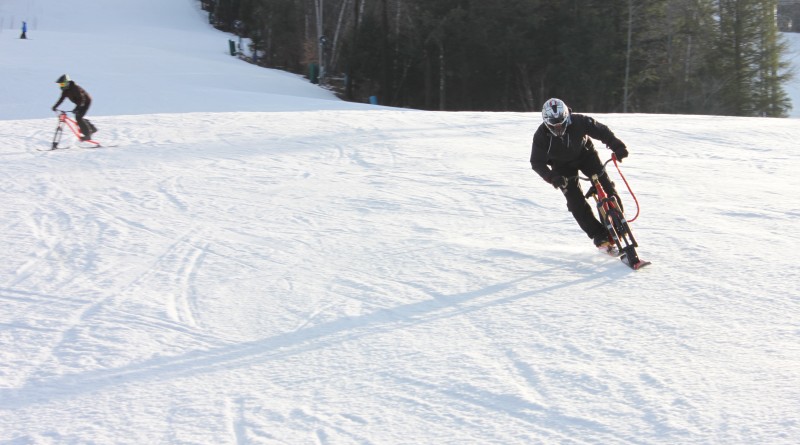Stephen Gellman and Cyndrome Cycles aim to bring ski-biking to the Northeast
By Evan Johnson

EASTON, MASS. — When Stephan Gellman was 13 and wanted a mountain bike, his dad said he had to work for it. Today, he’s making bikes as the owner and founder of Cyndrome Cycles, a small brand of bikes that he started in his garage.
OK, you say, what makes this story different than every other cycling-hobbyist-turned-bike-shop-owner? Gellman’s bikes don’t have tires. Using innovations of his own design, Gellman has combined two of his passions—skiing and snowboarding—into a more versatile and aggressive variety of ski bikes. While the bikes have grown in popularity among bikers in the Western United States, Gellman hopes to bring these machines into vogue in the Northeast.
“People move to Burke to bike, and they ski in their offseason. At the same time, there are a lot of people who move to Colorado to ski and they ride their bike in the offseason. I feel like this is sort of an ideal market for this activity,” he says. “People want to ride year-round.”
Gellman, now 35, grew up in a skiing and biking family. His father, an avid road biker, would ride 40 miles every morning before waking up the kids for school. Gellman learned to ski and ride a bike at the age of 3 and got his first job in a local bike shop at 13. He saved up his paychecks, bought his first mountain bike, and was hooked. At 14, he began competing in races. After studying engineering at college, he shifted his course and became a paramedic. In 2000, he joined the Army, went to flight school, and served three tours—two in Afghanistan and one in Iraq—as a flight medic, landing in areas to pick up and treat wounded while in-flight.
Biking and skiing continued to be his passions, even after he left the Army in 2004 and became a full-time paramedic and firefighter in his hometown, Easton, where he lives today in his childhood home.
Prototypes
When he wasn’t on call for the fire department, Gellman was riding and, in the winter, looked for an option to keep riding.
He wasn’t impressed with the options available.
While the largest brands had been making ski bikes with skis in place of tires for well over 50 years, the models also required small skis to be strapped to the bottom of the rider’s feet for stability; they also lacked the aggressive capability that Gellman preferred.
“You can’t jump them,” he says. “You can’t do any sort of freestyle stuff. They’re tricky to take in the woods; and if you go over any sort of bump, you’re taking one to the groin.”
These models also lent themselves easily to the “death wobbles,” and conversion kits featuring ski blades to clamp under the front and rear tires were easily broken; Gellman snapped the kit in two on his first run.
“It was a basic design that was a little bit too simplified,” he says—putting it gently.
In his earliest experiments in 2008, Gellman attached a ski blade to the rear axle of a downhill bike and half of a snowboard to the front. It was just a test, but a promising one. In doing this, Gellman placed both skis on the same axis, one in front of the other and made the ride more stable and maneuverable.
While prototyping, he partnered with two friends, Matt Michaud and Katie Mros, owners of Sandwich Tech Skis, a small ski-fabricating company in Littleton, New Hampshire. Both have master’s degrees in engineering and used to work with Gellman at Highland Mountain Bike Park in Northfield, New Hampshire. Unlike working with a major manufacturer, Gellman was able to order and test small batches of skis and then head back to the drawing board. He went through five prototypes before establishing a flagship model released in 2010.
Weighing in at 22.5 pounds, that model uses many preexisting bike components, including frames (he uses Lenz Sport from Colorado), seats, handlebars, and beefy front and rear suspensions from Fox Suspension. The skis are fully rockered and feature durable and flexible sugar maple and Ipe, a Brazilian hardwood. According to PSIA standards, Cyndrome Cycles are a classified Type 2 ski bike.
Like Riding a Bike
Riding one of Gellman’s ski bikes engages two sets of muscle memory; that of skiing or snowboarding with that of riding a bike. Like skiing, turns are initiated by exerting pressure on the downhill foot and engaging the downhill edge, but turns also require a biker’s sense of balance given the narrower base of the skis.
“It’s much like riding a bike,” Gellman says. “At lower speeds, you turn the handlebars to initiate the turn, and at higher speeds, you lean the bike to initiate the turn. There’s some body separation, in skiing or snowboarding, you’re moving most of your body, but in biking you can keep most of your upper body upright.”
With some practice, the bikes float through powder, maneuver through glades as easy as any downhill singletrack, and can carve giant slalom turns on groomed hardpack.
Given the variety of terrain they can tackle and the similarities to other popular activities, Gellman says the bikes are more accessible than people may originally think.
“A lot of our customers have been guys in their 50s and 60s who can’t really ski or snowboard because of bad knees or bad backs or ankles,” he says. “They’re able to hop on these with full suspension and go out with their buddies again.”
In the event of a crash, Gellman says it helps to be able to separate from the device. While skis and snowboards can exert torque on ligaments and joints, the ski bike stays attached to the rider through a leash strapped to the rider’s arm. Helmets are a good idea in any snow sport, and more advanced riders prefer full-face helmets popular in downhill biking.
Selling at $4,500 for a complete model, Cyndrome has sold 23 ski bikes so far. In the future, he says he plans to release four more models, a cheaper, price-point variety, and a higher-grade slalom-style bike.
Gellman says he could scale up production to as much as 200 bikes in a month, but at that point, he says, they would have to find more part manufacturers. For a guy already with a full-time job as a firefighter and paramedic, he’s not pushing Cyndrome too much. It’s a labor of love.
“I like having something that’s low stress,” he says. “Whether it’s pressing skis or going out and riding, it’s not life and death, it’s for fun. It’s to watch people smile.”
That doesn’t mean he’s not pushing the limits; last April, Gellman hiked Tuckerman Ravine with the bike strapped to his back and rode one of the most difficult lines. Meanwhile, Cliff Pinto, a biker in Colorado, made the first heli-drop on a Cyndrome snow bike at Silverton Mountain, Colorado.
And if he’s not pressing skis, assembling bikes, testing prototypes on the snow, or on-call at the fire station, he still has plenty to keep himself busy.
“I’ve got a 2-year-old daughter, and she’s way more fun,” he says. He’s taken her pint-sized Strider bike and converted it into a tiny ski bike that she pushes herself around on—and she’s getting the hang of it.
“She loves it, and who knows, maybe she’ll still want to ski bike with her dad when she’s 16,” he says.


